
How to Use 4 Channel Relay : Examples, Pinouts, and Specs
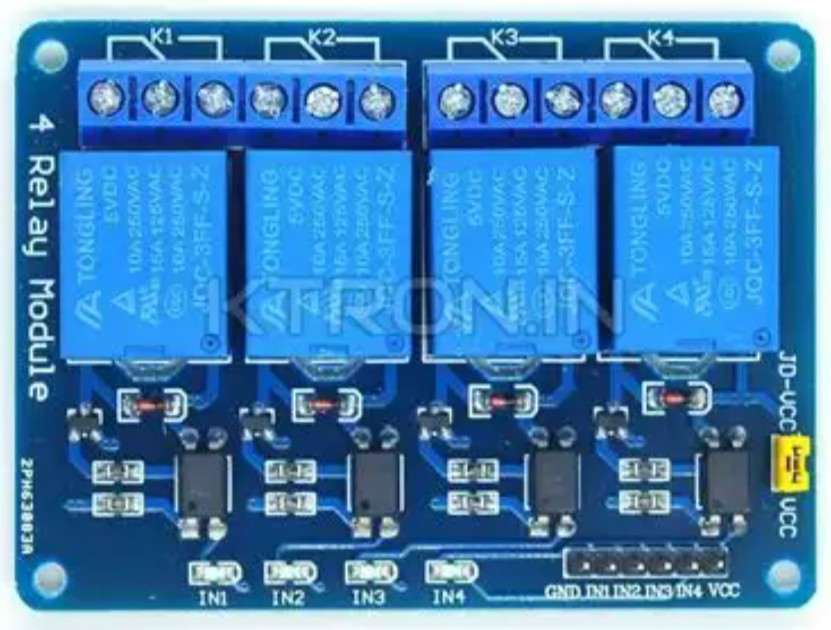
 Design with 4 Channel Relay in Cirkit Designer
Design with 4 Channel Relay in Cirkit DesignerIntroduction
The 4 Channel Relay by JLC PCB (Manufacturer Part ID: UNIO) is an electromechanical switch designed to control up to four independent circuits using a single control signal. This component is widely used in automation, home appliances, and industrial control systems. It allows low-power control signals, such as those from a microcontroller, to switch high-power devices like motors, lights, or other electrical loads.
Explore Projects Built with 4 Channel Relay
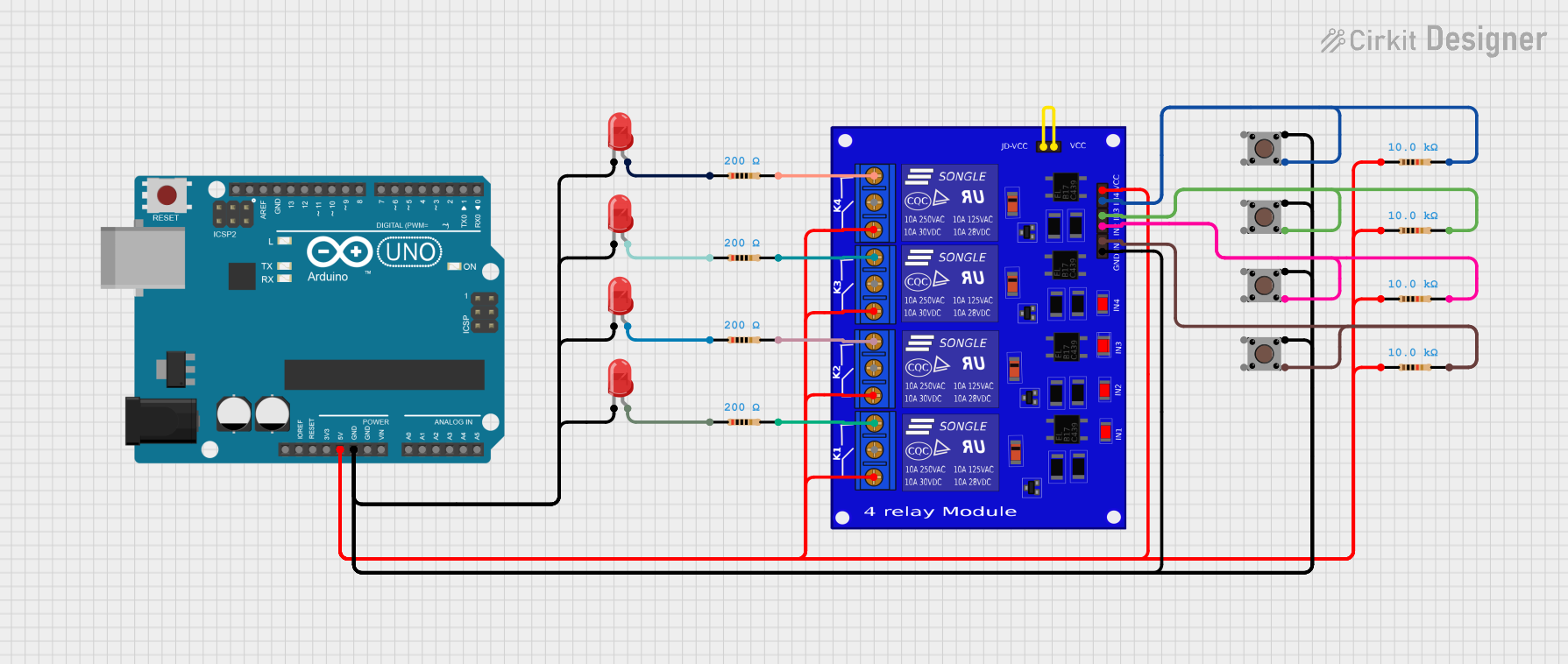
 Open Project in Cirkit Designer
Open Project in Cirkit Designer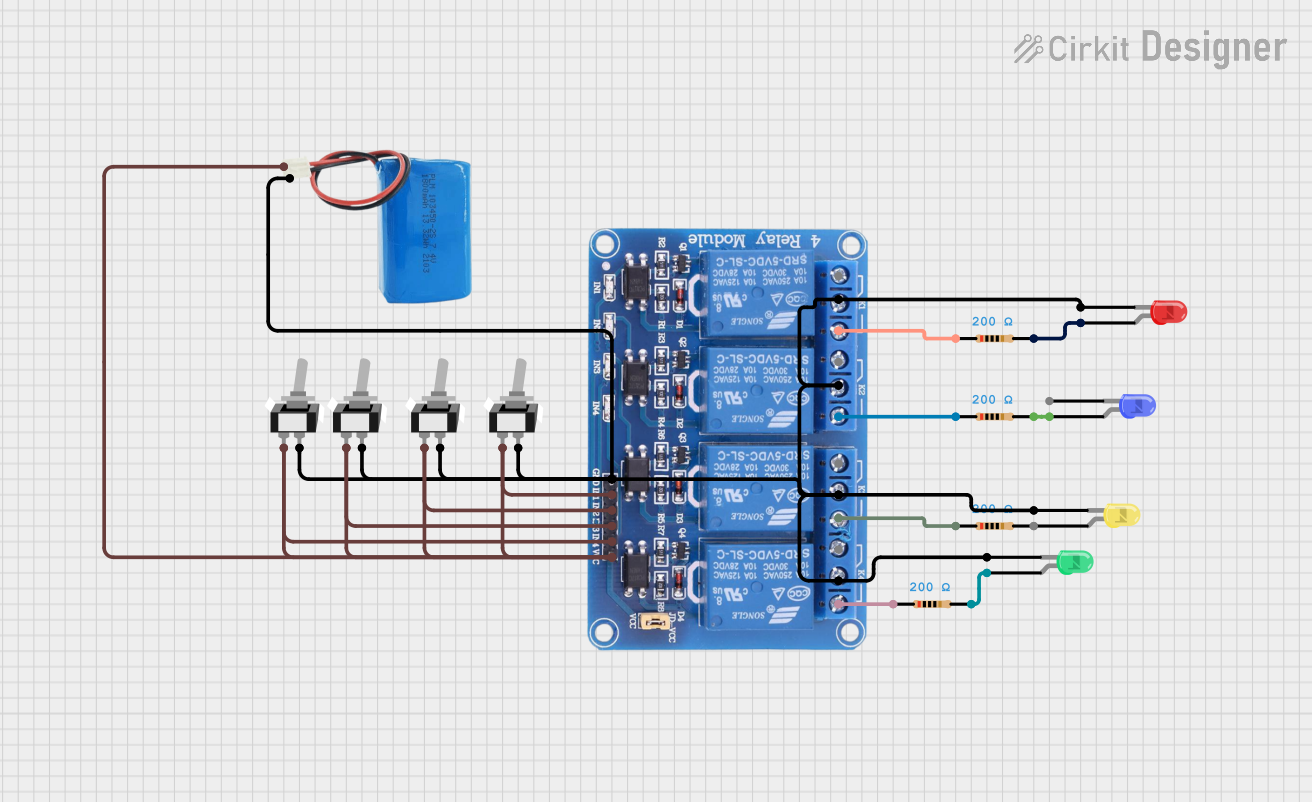
 Open Project in Cirkit Designer
Open Project in Cirkit Designer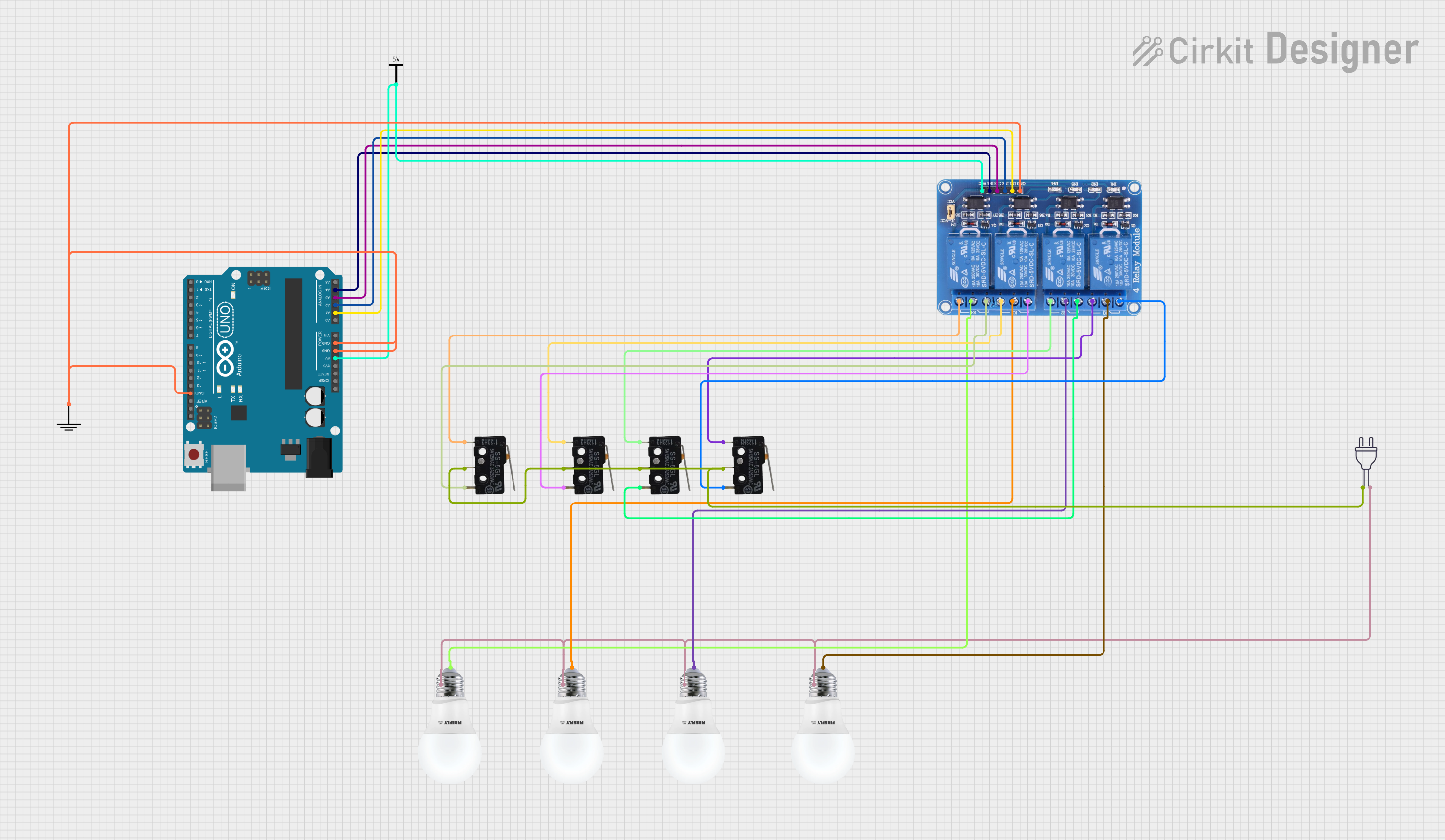
 Open Project in Cirkit Designer
Open Project in Cirkit Designer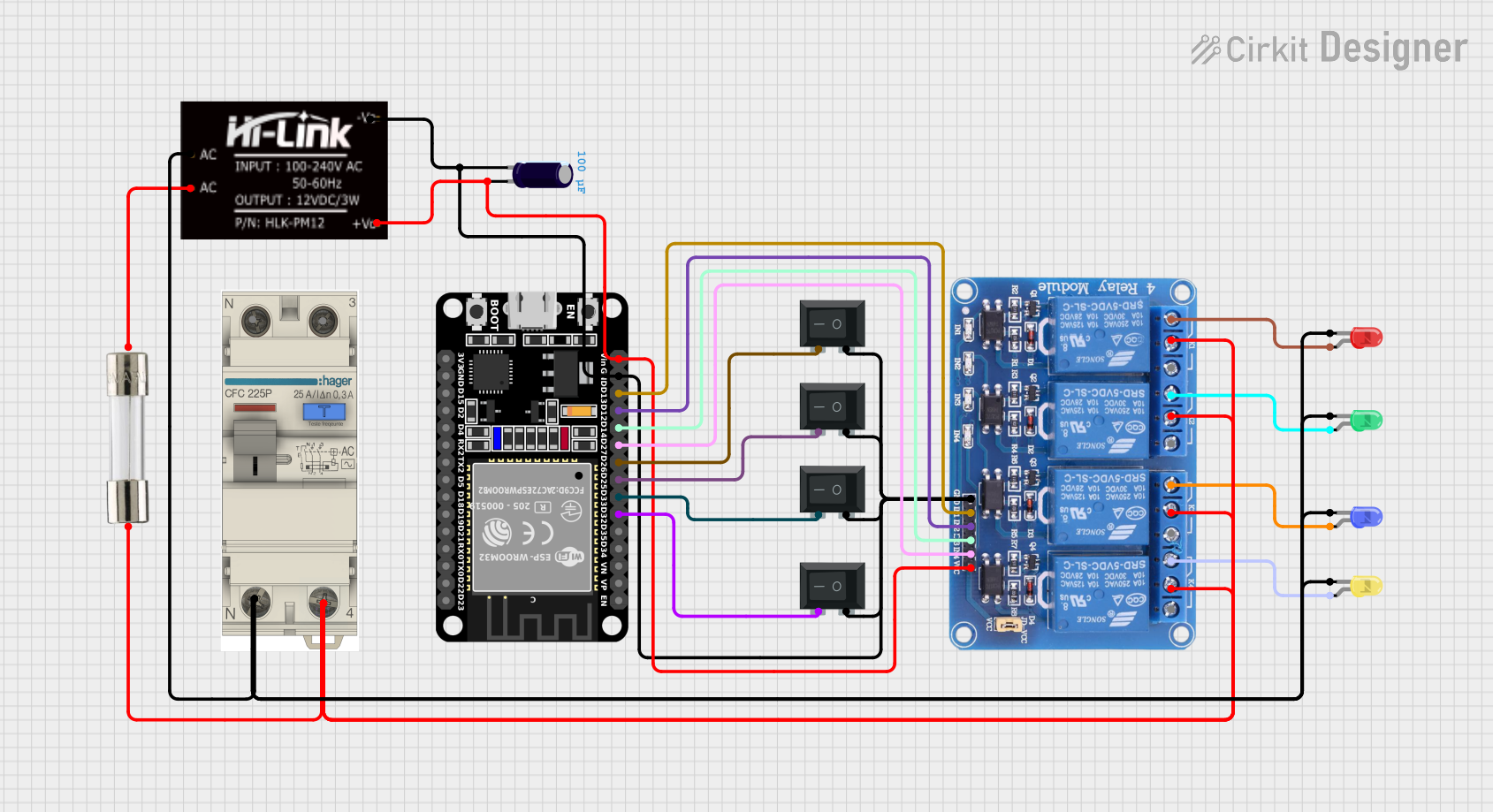
 Open Project in Cirkit Designer
Open Project in Cirkit DesignerExplore Projects Built with 4 Channel Relay

 Open Project in Cirkit Designer
Open Project in Cirkit Designer
 Open Project in Cirkit Designer
Open Project in Cirkit Designer
 Open Project in Cirkit Designer
Open Project in Cirkit Designer
 Open Project in Cirkit Designer
Open Project in Cirkit DesignerCommon Applications
- Home automation (e.g., controlling lights, fans, or appliances)
- Industrial automation and control systems
- Robotics and IoT projects
- Motor and pump control
- Security systems (e.g., activating alarms or locks)
Technical Specifications
The following table outlines the key technical details of the 4 Channel Relay:
| Parameter | Specification |
|---|---|
| Operating Voltage | 5V DC |
| Trigger Voltage | 3.3V to 5V DC (logic level) |
| Maximum Load Voltage | 250V AC / 30V DC |
| Maximum Load Current | 10A |
| Relay Type | SPDT (Single Pole Double Throw) |
| Isolation | Optocoupler isolation for each channel |
| Dimensions | 75mm x 55mm x 20mm |
| Weight | ~60g |
Pin Configuration and Descriptions
The 4 Channel Relay module has the following pin configuration:
Input Pins
| Pin | Name | Description |
|---|---|---|
| 1 | VCC | Power supply input (5V DC) |
| 2 | GND | Ground connection |
| 3 | IN1 | Control signal for Relay 1 (Active LOW) |
| 4 | IN2 | Control signal for Relay 2 (Active LOW) |
| 5 | IN3 | Control signal for Relay 3 (Active LOW) |
| 6 | IN4 | Control signal for Relay 4 (Active LOW) |
Output Terminals (Relay Contacts)
Each relay has three output terminals:
| Terminal | Name | Description |
|---|---|---|
| 1 | NO (Normally Open) | Open circuit when the relay is inactive; closed when the relay is activated. |
| 2 | COM (Common) | Common terminal for the relay. |
| 3 | NC (Normally Closed) | Closed circuit when the relay is inactive; open when the relay is activated. |
Usage Instructions
How to Use the 4 Channel Relay in a Circuit
- Power the Relay Module: Connect the VCC pin to a 5V DC power source and the GND pin to the ground.
- Connect Control Signals: Use a microcontroller (e.g., Arduino UNO) to send control signals to the IN1, IN2, IN3, and IN4 pins. These signals should be logic LOW to activate the corresponding relay.
- Connect the Load: For each relay, connect the load to the NO, NC, and COM terminals as required:
- Use the NO terminal if you want the load to be off by default and turn on when the relay is activated.
- Use the NC terminal if you want the load to be on by default and turn off when the relay is activated.
- Ensure Proper Isolation: The module includes optocouplers for isolation, but ensure that the high-power side and low-power side are properly separated to avoid damage.
Example: Controlling the Relay with Arduino UNO
Below is an example code to control the 4 Channel Relay using an Arduino UNO:
// Define the relay control pins
#define RELAY1 2 // Pin connected to IN1
#define RELAY2 3 // Pin connected to IN2
#define RELAY3 4 // Pin connected to IN3
#define RELAY4 5 // Pin connected to IN4
void setup() {
// Set relay pins as outputs
pinMode(RELAY1, OUTPUT);
pinMode(RELAY2, OUTPUT);
pinMode(RELAY3, OUTPUT);
pinMode(RELAY4, OUTPUT);
// Initialize all relays to OFF state
digitalWrite(RELAY1, HIGH); // HIGH = Relay OFF (Active LOW)
digitalWrite(RELAY2, HIGH);
digitalWrite(RELAY3, HIGH);
digitalWrite(RELAY4, HIGH);
}
void loop() {
// Example: Turn on Relay 1 for 2 seconds, then turn it off
digitalWrite(RELAY1, LOW); // LOW = Relay ON
delay(2000); // Wait for 2 seconds
digitalWrite(RELAY1, HIGH); // Turn off Relay 1
// Example: Turn on all relays for 1 second, then turn them off
digitalWrite(RELAY1, LOW);
digitalWrite(RELAY2, LOW);
digitalWrite(RELAY3, LOW);
digitalWrite(RELAY4, LOW);
delay(1000); // Wait for 1 second
digitalWrite(RELAY1, HIGH);
digitalWrite(RELAY2, HIGH);
digitalWrite(RELAY3, HIGH);
digitalWrite(RELAY4, HIGH);
}
Important Considerations
- Power Supply: Ensure the relay module is powered with a stable 5V DC supply. Using a lower voltage may cause unreliable operation.
- Load Ratings: Do not exceed the maximum load voltage (250V AC / 30V DC) or current (10A) for each relay.
- Isolation: Always maintain proper isolation between the low-power control side and the high-power load side to prevent damage or hazards.
- Active LOW Logic: The relays are activated when the control signal is LOW. Ensure your microcontroller logic matches this behavior.
Troubleshooting and FAQs
Common Issues and Solutions
Relays Not Activating
- Cause: Insufficient power supply or incorrect wiring.
- Solution: Verify that the VCC and GND pins are properly connected to a 5V DC power source. Check the control signal connections.
Relay Stuck in ON or OFF State
- Cause: Faulty relay or incorrect control signal logic.
- Solution: Test the relay with a direct LOW signal to the IN pin. If it still doesn't work, the relay may be damaged.
Microcontroller Resetting When Relay Activates
- Cause: Voltage spikes or insufficient power supply.
- Solution: Add a flyback diode across the relay coil and ensure the power supply can handle the current draw.
Load Not Switching Properly
- Cause: Incorrect wiring of the load to the relay terminals.
- Solution: Double-check the connections to the NO, NC, and COM terminals. Ensure the load voltage and current are within the relay's specifications.
FAQs
Q: Can I use a 3.3V microcontroller to control the relay?
A: Yes, the relay module supports trigger voltages as low as 3.3V. However, ensure the microcontroller's output current is sufficient to drive the relay.Q: Can I control AC and DC loads with this relay?
A: Yes, the relay can switch both AC (up to 250V) and DC (up to 30V) loads, as long as the current does not exceed 10A.Q: Is it safe to use this relay for high-power applications?
A: Yes, but ensure proper isolation and use additional safety measures like fuses or circuit breakers for high-power loads.
This concludes the documentation for the 4 Channel Relay by JLC PCB.